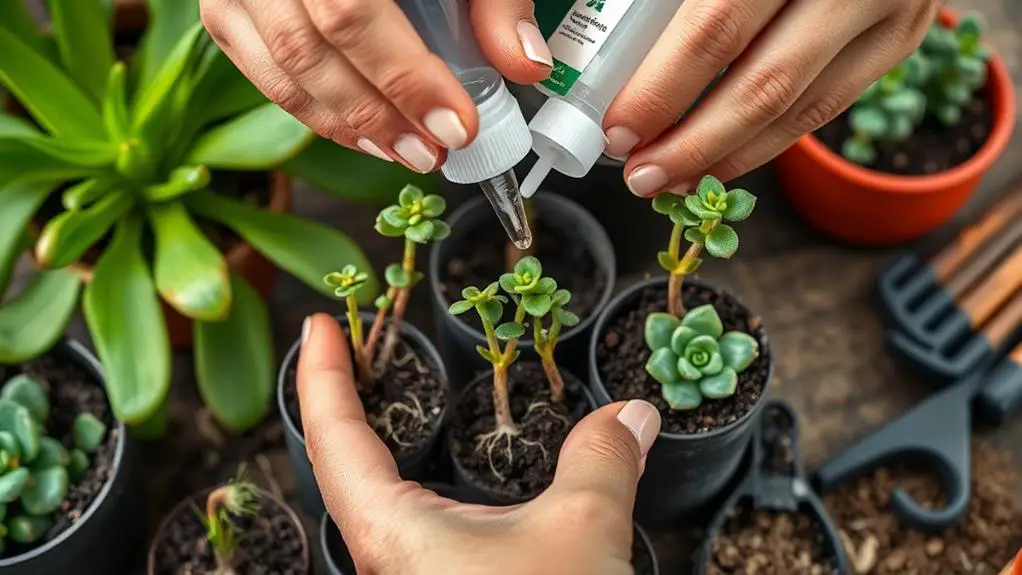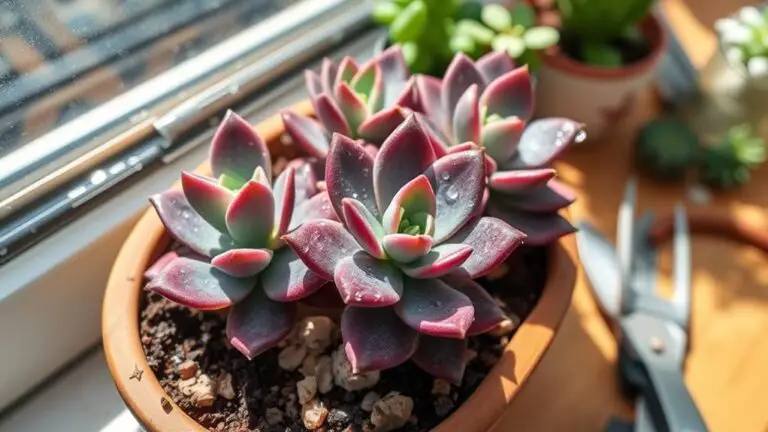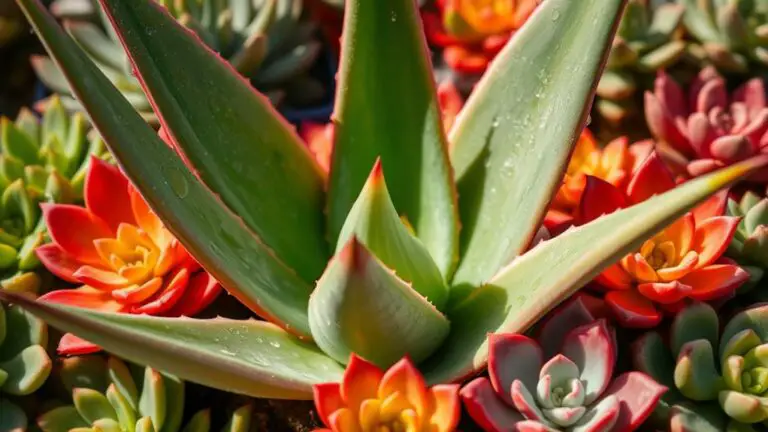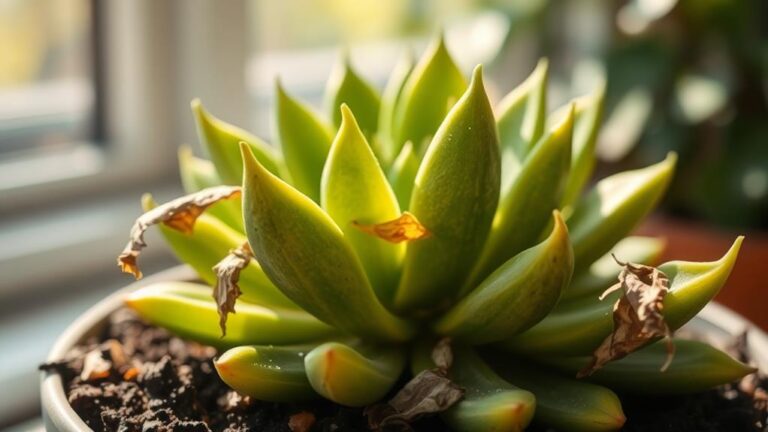Stimulate Root Growth in Succulents – Step-by-Step Guide
If you want to stimulate root growth in your succulents, it's essential to start with the right approach. First, gather healthy cuttings, ideally during spring or summer, and let them dry for a few days. This step guarantees the cut ends callous over, a key part of successful rooting. Next, the choice of potting mix can make or break your efforts. You'll need a well-draining mix to mimic their natural habitat. But what about the little-known tricks like using cinnamon or honey for rooting? And how should you handle watering to avoid rot? Let's explore these steps further.
Preparing the Potting Mix
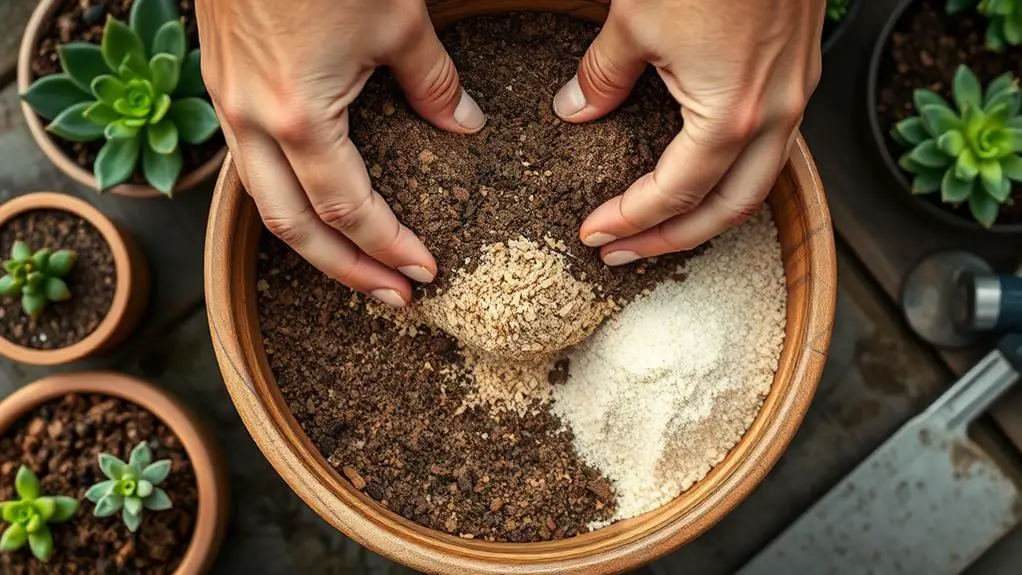
To guarantee your succulents thrive, preparing the potting mix with care is necessary. A well-draining potting mix is essential for healthy root development in succulents.
You'll want to combine equal parts of potting soil, coarse sand, and perlite. This blend guarantees ideal drainage and aeration, preventing water from pooling around the roots.
Including components like pumice and black volcanic stone can further enhance the mix. These elements improve drainage and airflow, which are critical for succulent roots.
Avoid overly dense or moisture-retaining mixes, as they can lead to root rot, a common issue for succulents.
To boost the potting mix's antifungal properties, add some charcoal. This addition helps prevent root rot by keeping harmful fungi at bay, promoting healthier root systems.
Regularly check the drainage capabilities of your mix to confirm it maintains the right balance of moisture retention and airflow.
Taking Succulent Cuttings
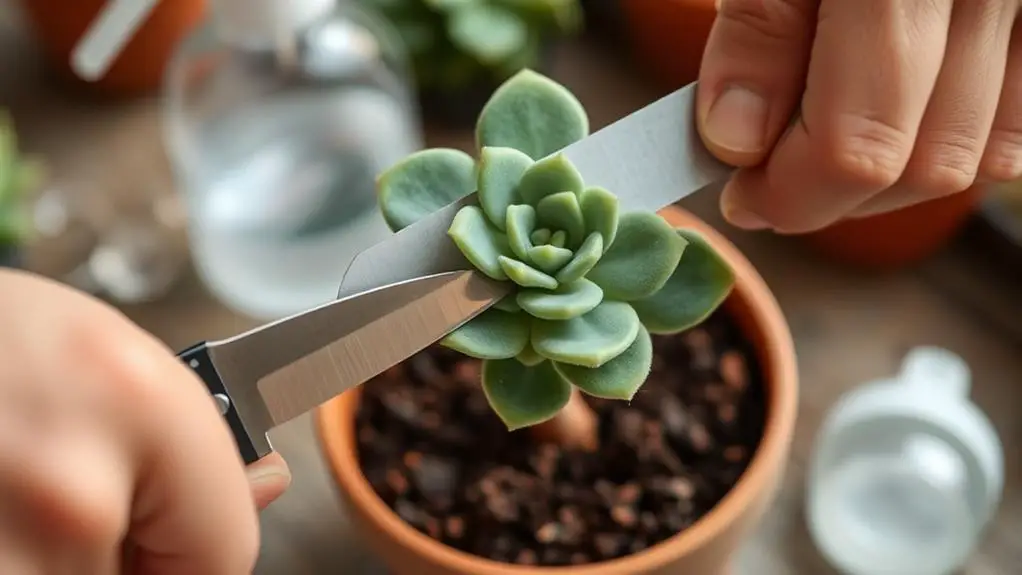
After preparing the ideal potting mix, it's time to focus on taking succulent cuttings for propagation. The best time for this is during spring and summer when your succulents are in active growth.
Start by using a sharp knife or craft scissors to make clean cuts. Aim for cuttings that are 2-3 inches long, ensuring the base of the leaf or stem remains intact to stimulate root growth.
Once you've taken your cuttings, allow them to dry and callous for 2-3 days in a shaded area. This step is vital to prevent rot.
Although optional, applying a rooting hormone, like cinnamon powder or honey, can enhance root development and protect the cuttings from fungal infections.
After the cut ends have calloused, they're ready for the next step. Remember, well-draining soil is essential for succulent propagation.
As you move forward, monitor the cuttings for signs of new growth, which usually appear within 2-3 weeks. This growth indicates successful rooting and establishment.
Keep your cuttings in a spot with indirect sunlight and avoid overwatering. With these steps, you'll be well on your way to growing healthy new succulents!
Planting the Cuttings
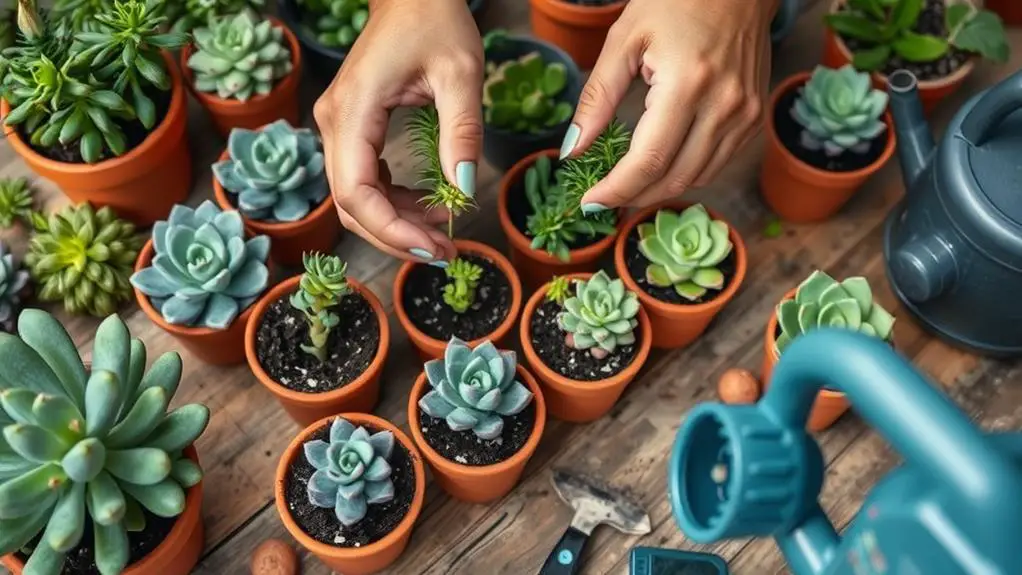
Planting succulent cuttings requires careful attention to detail to secure successful growth.
Start by preparing a well-draining potting mix. You can create a good mix with pumice, black volcanic stone, and some regular potting soil. This helps the roots grow without rotting.
Next, take your cuttings and make certain the lower part is buried in the soil, but keep the cut end slightly above the surface. This lets the cut end heal and dry before planting.
After placing the cuttings in the soil, resist the urge to water them immediately. Wait about 1-2 weeks. This waiting period allows any damaged roots to heal, reducing the risk of root rot.
When it's finally time to water, do so cautiously. Confirm the soil is thoroughly soaked, then let it dry out completely before the next watering. This helps establish a healthy watering routine.
Your succulent cuttings also need a warm environment with indirect light. Adequate light and temperature are key for promoting healthy root growth.
Caring for New Plants
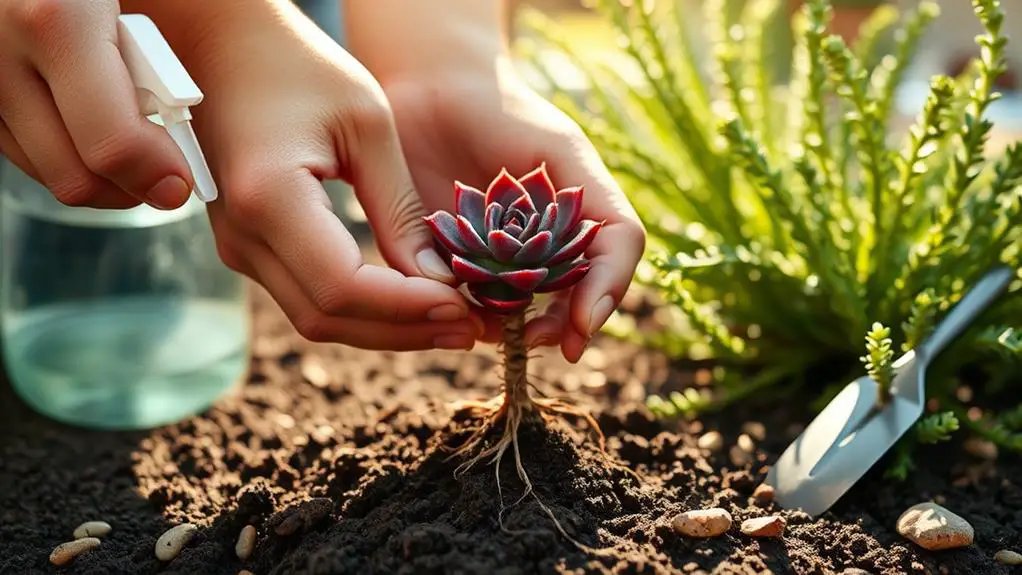
Once your succulent cuttings are planted, the next essential step is to guarantee proper care to promote their growth.
Start by placing your new plants in bright, indirect light. This helps them grow without risking sunburn. Remember, succulents need light, but not too much at first. Avoid direct sunlight for the first few weeks after transplanting to help the plant adjust and strengthen its root system.
Water your new succulents every 2-3 weeks, or when the soil feels dry to the touch. Overwatering can lead to root rot, so it's better to err on the side of caution. Succulents store water in their leaves, so they don't need frequent watering.
Monitor your plants for signs of new growth. Look for swelling at the base or new leaf formation. These are good indicators that the roots are establishing well.
As for fertilizing, use a diluted liquid seaweed solution sparingly. This will support growth without overwhelming the plant.
Taking these steps guarantees your succulents stay healthy and thrive. With the right care, you'll see your plants grow strong roots and flourish in no time.
Happy gardening!
Monitoring Growth and Adjustments
Now that your succulents are well-planted and receiving the right initial care, it's important to keep a close eye on their progress. Regularly monitoring growth is vital. Look for signs of new growth, like pink roots or new leaves. These indicate successful root development.
Adjust your watering routine based on soil moisture. Let the soil dry out completely between waterings to prevent root rot.
Light exposure is another key factor. If your succulents show leggy growth or if lower leaves wither and fall off, move them to a brighter spot. This guarantees they get enough sunlight to thrive.
Keep an eye on the overall health of your plants. Signs of stress, such as discoloration or drooping, may suggest they need changes in care.
Be patient, as root development can take several weeks. Avoid disturbing the soil or plant during this time to allow roots to establish properly.
Consistently checking on your succulents' growth and making necessary adjustments will help them stay healthy and flourish. Remember, patience is vital in gardening.
With the right care, your succulents will reward you with beautiful growth and vibrant health.
Frequently Asked Questions
How to Promote Root Growth in Succulents?
You can promote root growth in succulents by soaking the soil three times a week, using well-draining soil, letting cuttings callus, applying natural rooting hormones, and keeping new cuttings out of direct sunlight until roots are strong.
What Is a Homemade Root Stimulator for Succulents?
You can make a homemade root stimulator for succulents by mixing honey, cinnamon powder, or diluted apple cider vinegar. These natural ingredients protect the cuttings and promote root growth, giving your succulents a healthy start.
How to Save a Succulent With No Roots?
To save a succulent with no roots, let the cutting dry for 2-3 days. Use well-draining soil, apply a natural rooting hormone, and place it in a warm, indirect light. Water sparingly once roots form.
Why Do You Put Cinnamon on Succulents?
You put cinnamon on succulents because it has anti-fungal properties that prevent diseases and infections. It also acts as a natural rooting hormone, promoting root growth and ensuring your succulent cuttings stay healthy and thrive.
Conclusion
You've got this! By following these steps, you're well on your way to growing healthy succulents with strong roots. Just remember to be patient and monitor your plants' progress. Give them the right care with well-draining soil, cautious watering, and plenty of indirect light. Soon, you'll see those roots taking hold and your succulents thriving. Keep experimenting and learning, and you'll become a succulent-growing pro in no time. Happy gardening!

